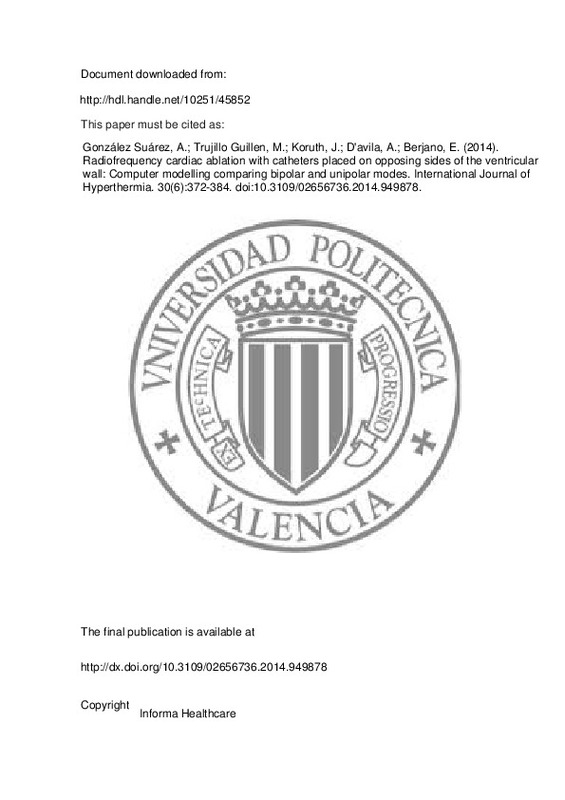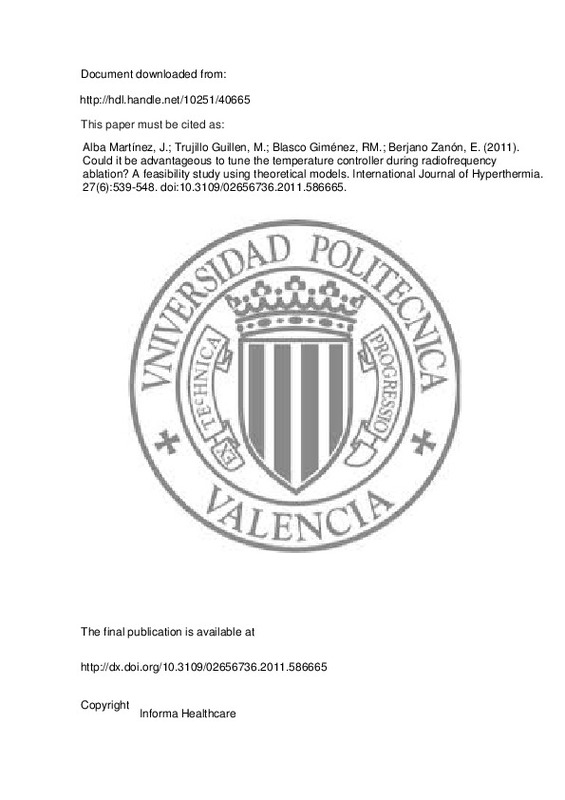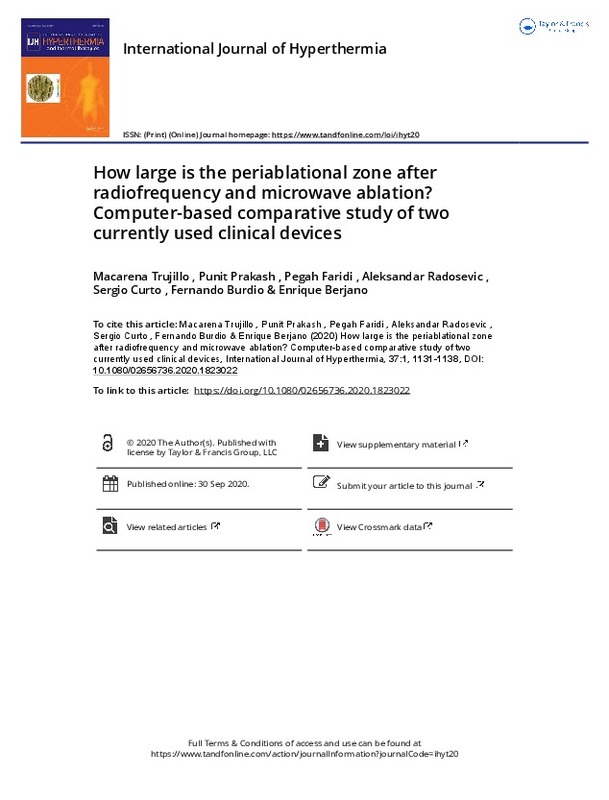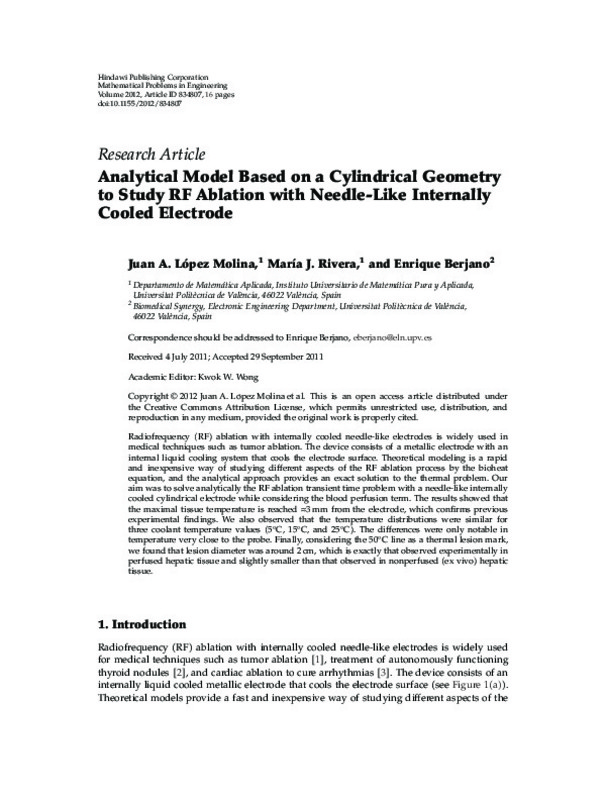JavaScript is disabled for your browser. Some features of this site may not work without it.
Buscar en RiuNet
Listar
Mi cuenta
Estadísticas
Ayuda RiuNet
Admin. UPV
Radiofrequency cardiac ablation with catheters placed on opposing sides of the ventricular wall: Computer modelling comparing bipolar and unipolar modes
Mostrar el registro sencillo del ítem
Ficheros en el ítem
| dc.contributor.author | González Suárez, Ana
|
es_ES |
| dc.contributor.author | Trujillo Guillen, Macarena
|
es_ES |
| dc.contributor.author | Koruth, Jacob
|
es_ES |
| dc.contributor.author | d'Avila, Andre
|
es_ES |
| dc.contributor.author | Berjano, Enrique
|
es_ES |
| dc.date.accessioned | 2015-01-07T18:22:04Z | |
| dc.date.available | 2015-01-07T18:22:04Z | |
| dc.date.issued | 2014-09 | |
| dc.identifier.issn | 0265-6736 | |
| dc.identifier.uri | http://hdl.handle.net/10251/45852 | |
| dc.description.abstract | Purpose: The aim of this study was to compare the efficacy of bipolar (BM) vs. unipolar (UM) mode of radiofrequency ablation (RFA) in terms of creating transmural lesions across the interventricular septum (IVS) and ventricular free wall (VFW). Materials and methods: We built computational models to study the temperature distributions and lesion dimensions created by BM and UM on IVS and VFW during RFA. Two different UM types were considered: sequential (SeUM) and simultaneous (SiUM). The effect of ventricular wall thickness, catheter misalignment, epicardial fat, and presence of air in the epicardial space were also studied. Results: Regarding IVS ablation, BM created transmural and symmetrical lesions for wall thicknesses up to 15 mm. SeUM and SiUM were not able to create transmural lesions with IVS thicknesses >= 12.5 and 15 mm, respectively. Lesions were asymmetrical only with SeUM. For VFW ablation, BM also created transmural lesions for wall thicknesses up to 15 mm. However, with SeUM and SiUM transmurality was obtained for VFW thicknesses <= 7.5 and 12.5 mm, respectively. With the three modes, VFW lesions were always asymmetrical. In the scenario with air or a fat tissue layer on the epicardial side, only SiUM was capable of creating transmural lesions. Overall, BM was superior to UM in IVS and VFW ablation when the catheters were not aligned. Conclusions: Our findings suggest that BM is more effective than UM in achieving transmurality across both ventricular sites, except in the situation of the epicardial catheter tip surrounded by air or placed over a fat tissue layer. | es_ES |
| dc.description.sponsorship | This work received financial support from the Spanish 'Plan Nacional de I+D+I del Ministerio de Ciencia e Innovacion' (TEC2011-27133-C02-01), and from the Universitat Politecnica de Valencia (PAID-06-11 Ref. 1988). A. Gonzalez-Suarez is the recipient of a Grant VaLi+D (ACIF/2011/194) from the Generalitat Valenciana, Spain. The authors alone are responsible for the content and writing of the paper. | en_EN |
| dc.language | Inglés | es_ES |
| dc.publisher | Informa Healthcare | es_ES |
| dc.relation.ispartof | International Journal of Hyperthermia | es_ES |
| dc.rights | Reserva de todos los derechos | es_ES |
| dc.subject | Bipolar ablation | es_ES |
| dc.subject | Interventricular septum | es_ES |
| dc.subject | Radiofrequency ablation | es_ES |
| dc.subject | Unipolar ablation | es_ES |
| dc.subject | Ventricular ablation | es_ES |
| dc.subject | Ventricular free wall | es_ES |
| dc.subject.classification | MATEMATICA APLICADA | es_ES |
| dc.subject.classification | TECNOLOGIA ELECTRONICA | es_ES |
| dc.title | Radiofrequency cardiac ablation with catheters placed on opposing sides of the ventricular wall: Computer modelling comparing bipolar and unipolar modes | es_ES |
| dc.type | Artículo | es_ES |
| dc.identifier.doi | 10.3109/02656736.2014.949878 | |
| dc.relation.projectID | info:eu-repo/grantAgreement/MICINN//TEC2011-27133-C02-01/ES/MODELADO TEORICO Y EXPERIMENTACION PARA TECNICAS ABLATIVAS BASADAS EN ENERGIAS/ | es_ES |
| dc.relation.projectID | info:eu-repo/grantAgreement/UPV//PAID-06-11-1988/ | es_ES |
| dc.relation.projectID | info:eu-repo/grantAgreement/GVA//ACIF%2F2011%2F194/ | es_ES |
| dc.rights.accessRights | Abierto | es_ES |
| dc.contributor.affiliation | Universitat Politècnica de València. Departamento de Matemática Aplicada - Departament de Matemàtica Aplicada | es_ES |
| dc.contributor.affiliation | Universitat Politècnica de València. Departamento de Ingeniería Electrónica - Departament d'Enginyeria Electrònica | es_ES |
| dc.description.bibliographicCitation | González Suárez, A.; Trujillo Guillen, M.; Koruth, J.; D'avila, A.; Berjano, E. (2014). Radiofrequency cardiac ablation with catheters placed on opposing sides of the ventricular wall: Computer modelling comparing bipolar and unipolar modes. International Journal of Hyperthermia. 30(6):372-384. https://doi.org/10.3109/02656736.2014.949878 | es_ES |
| dc.description.accrualMethod | S | es_ES |
| dc.relation.publisherversion | http://dx.doi.org/10.3109/02656736.2014.949878 | es_ES |
| dc.description.upvformatpinicio | 372 | es_ES |
| dc.description.upvformatpfin | 384 | es_ES |
| dc.type.version | info:eu-repo/semantics/publishedVersion | es_ES |
| dc.description.volume | 30 | es_ES |
| dc.description.issue | 6 | es_ES |
| dc.relation.senia | 271598 | |
| dc.contributor.funder | Ministerio de Ciencia e Innovación | es_ES |
| dc.contributor.funder | Universitat Politècnica de València | es_ES |
| dc.contributor.funder | Generalitat Valenciana | es_ES |
| dc.description.references | SIVAGANGABALAN, G., BARRY, M. A., HUANG, K., LU, J., POULIOPOULOS, J., THOMAS, S. P., … KOVOOR, P. (2010). Bipolar Ablation of the Interventricular Septum is More Efficient at Creating a Transmural Line than Sequential Unipolar Ablation. Pacing and Clinical Electrophysiology, 33(1), 16-26. doi:10.1111/j.1540-8159.2009.02602.x | es_ES |
| dc.description.references | Nagashima, K., Watanabe, I., Okumura, Y., Ohkubo, K., Kofune, M., Ohya, T., … Hirayama, A. (2011). Lesion Formation by Ventricular Septal Ablation With Irrigated Electrodes. Circulation Journal, 75(3), 565-570. doi:10.1253/circj.cj-10-0870 | es_ES |
| dc.description.references | D’ Avila, A., Houghtaling, C., Gutierrez, P., Vragovic, O., Ruskin, J. N., Josephson, M. E., & Reddy, V. Y. (2004). Catheter Ablation of Ventricular Epicardial Tissue. Circulation, 109(19), 2363-2369. doi:10.1161/01.cir.0000128039.87485.0b | es_ES |
| dc.description.references | Dukkipati, S. R., d’ Avila, A., Soejima, K., Bala, R., Inada, K., Singh, S., … Reddy, V. Y. (2011). Long-Term Outcomes of Combined Epicardial and Endocardial Ablation of Monomorphic Ventricular Tachycardia Related to Hypertrophic Cardiomyopathy. Circulation: Arrhythmia and Electrophysiology, 4(2), 185-194. doi:10.1161/circep.110.957290 | es_ES |
| dc.description.references | Sosa, E., Scanavacca, M., d’ Avila, A., Oliveira, F., & Ramires, J. A. F. (2000). Nonsurgical transthoracic epicardial catheter ablation to treat recurrent ventricular tachycardia occurring late after myocardial infarction. Journal of the American College of Cardiology, 35(6), 1442-1449. doi:10.1016/s0735-1097(00)00606-9 | es_ES |
| dc.description.references | Nagashima, K., Watanabe, I., Okumura, Y., Sonoda, K., Kofune, M., Mano, H., … Hirayama, A. (2012). Epicardial Ablation With Irrigated Electrodes. Circulation Journal, 76(2), 322-327. doi:10.1253/circj.cj-11-0984 | es_ES |
| dc.description.references | Berjano, E. J. (2006). BioMedical Engineering OnLine, 5(1), 24. doi:10.1186/1475-925x-5-24 | es_ES |
| dc.description.references | Abraham, J. P., & Sparrow, E. M. (2007). A thermal-ablation bioheat model including liquid-to-vapor phase change, pressure- and necrosis-dependent perfusion, and moisture-dependent properties. International Journal of Heat and Mass Transfer, 50(13-14), 2537-2544. doi:10.1016/j.ijheatmasstransfer.2006.11.045 | es_ES |
| dc.description.references | Jo, B., & Aksan, A. (2010). Prediction of the extent of thermal damage in the cornea during conductive keratoplasty. Journal of Thermal Biology, 35(4), 167-174. doi:10.1016/j.jtherbio.2010.02.004 | es_ES |
| dc.description.references | HAINES, D. E., & WATSON, D. D. (1989). Tissue Heating During Radiofrequency Catheter Ablation: A Thermodynamic Model and Observations in Isolated Perfused and Superfused Canine Right Ventricular Free Wall. Pacing and Clinical Electrophysiology, 12(6), 962-976. doi:10.1111/j.1540-8159.1989.tb05034.x | es_ES |
| dc.description.references | Zhao, G., Zhang, H.-F., Guo, X.-J., Luo, D.-W., & Gao, D.-Y. (2007). Effect of blood flow and metabolism on multidimensional heat transfer during cryosurgery. Medical Engineering & Physics, 29(2), 205-215. doi:10.1016/j.medengphy.2006.03.005 | es_ES |
| dc.description.references | Chang, I. A., & Nguyen, U. D. (2004). BioMedical Engineering OnLine, 3(1), 27. doi:10.1186/1475-925x-3-27 | es_ES |
| dc.description.references | Whitney, J., Carswell, W., & Rylander, N. (2013). Arrhenius parameter determination as a function of heating method and cellular microenvironment based on spatial cell viability analysis. International Journal of Hyperthermia, 29(4), 281-295. doi:10.3109/02656736.2013.802375 | es_ES |
| dc.description.references | Pearce, J. A. (2013). Comparative analysis of mathematical models of cell death and thermal damage processes. International Journal of Hyperthermia, 29(4), 262-280. doi:10.3109/02656736.2013.786140 | es_ES |
| dc.description.references | Doss, J. D. (1982). Calculation of electric fields in conductive media. Medical Physics, 9(4), 566-573. doi:10.1118/1.595107 | es_ES |
| dc.description.references | Watanabe, I., Nuo, M., Okumura, Y., Ohkubo, K., Ashino, S., Kofune, M., … Hirayama, A. (2010). Temperature-Controlled Cooled-Tip Radiofrequency Ablation in Left Ventricular Myocardium. International Heart Journal, 51(3), 193-198. doi:10.1536/ihj.51.193 | es_ES |
| dc.description.references | Yokoyama, K., Nakagawa, H., Wittkampf, F. H. M., Pitha, J. V., Lazzara, R., & Jackman, W. M. (2006). Comparison of Electrode Cooling Between Internal and Open Irrigation in Radiofrequency Ablation Lesion Depth and Incidence of Thrombus and Steam Pop. Circulation, 113(1), 11-19. doi:10.1161/circulationaha.105.540062 | es_ES |
| dc.description.references | Kumar, P., Mounsey, J. P., Gehi, A. K., Schwartz, J. D., & Chung, E. H. (2013). Use of a closed loop irrigated catheter in epicardial ablation of ventricular tachycardia. Journal of Interventional Cardiac Electrophysiology, 38(1), 35-42. doi:10.1007/s10840-013-9799-1 | es_ES |
| dc.description.references | Schutt, D., Berjano, E. J., & Haemmerich, D. (2009). Effect of electrode thermal conductivity in cardiac radiofrequency catheter ablation: A computational modeling study. International Journal of Hyperthermia, 25(2), 99-107. doi:10.1080/02656730802563051 | es_ES |
| dc.description.references | Gopalakrishnan, J. (2002). A Mathematical Model for Irrigated Epicardial Radiofrequency Ablation. Annals of Biomedical Engineering, 30(7), 884-893. doi:10.1114/1.1507845 | es_ES |
| dc.description.references | Suárez, A. G., Hornero, F., & Berjano, E. J. (2010). Mathematical Modeling of Epicardial RF Ablation of Atrial Tissue with Overlying Epicardial Fat. The Open Biomedical Engineering Journal, 4(1), 47-55. doi:10.2174/1874120701004020047 | es_ES |
| dc.description.references | Haemmerich, D., Chachati, L., Wright, A. S., Mahvi, D. M., Lee, F. T., & Webster, J. G. (2003). Hepatic radiofrequency ablation with internally cooled probes: effect of coolant temperature on lesion size. IEEE Transactions on Biomedical Engineering, 50(4), 493-500. doi:10.1109/tbme.2003.809488 | es_ES |
| dc.description.references | Koruth, J. S., Dukkipati, S., Miller, M. A., Neuzil, P., d’ Avila, A., & Reddy, V. Y. (2012). Bipolar irrigated radiofrequency ablation: A therapeutic option for refractory intramural atrial and ventricular tachycardia circuits. Heart Rhythm, 9(12), 1932-1941. doi:10.1016/j.hrthm.2012.08.001 | es_ES |
| dc.description.references | González-Suárez, A., Trujillo, M., Burdío, F., Andaluz, A., & Berjano, E. (2012). Feasibility study of an internally cooled bipolar applicator for RF coagulation of hepatic tissue: Experimental and computational study. International Journal of Hyperthermia, 28(7), 663-673. doi:10.3109/02656736.2012.716900 | es_ES |
| dc.description.references | Agah, R., Gandjbakhche, A. H., Motamedi, M., Nossal, R., & Bonner, R. F. (1996). Dynamics of temperature dependent optical properties of tissue: dependence on thermally induced alteration. IEEE Transactions on Biomedical Engineering, 43(8), 839-846. doi:10.1109/10.508546 | es_ES |
| dc.description.references | Haines, D. E. (2011). Letter by Haines Regarding Article, «Direct Measurement of the Lethal Isotherm for Radiofrequency Ablation of Myocardial Tissue». Circulation: Arrhythmia and Electrophysiology, 4(5). doi:10.1161/circep.111.965459 | es_ES |
| dc.description.references | Wood, M., Goldberg, S., Lau, M., Goel, A., Alexander, D., Han, F., & Feinstein, S. (2011). Direct Measurement of the Lethal Isotherm for Radiofrequency Ablation of Myocardial Tissue. Circulation: Arrhythmia and Electrophysiology, 4(3), 373-378. doi:10.1161/circep.110.961169 | es_ES |
| dc.description.references | Jain, M. K., & Wolf, P. D. (2000). A Three-Dimensional Finite Element Model of Radiofrequency Ablation with Blood Flow and its Experimental Validation. Annals of Biomedical Engineering, 28(9), 1075-1084. doi:10.1114/1.1310219 | es_ES |







![[Cerrado]](/themes/UPV/images/candado.png)




